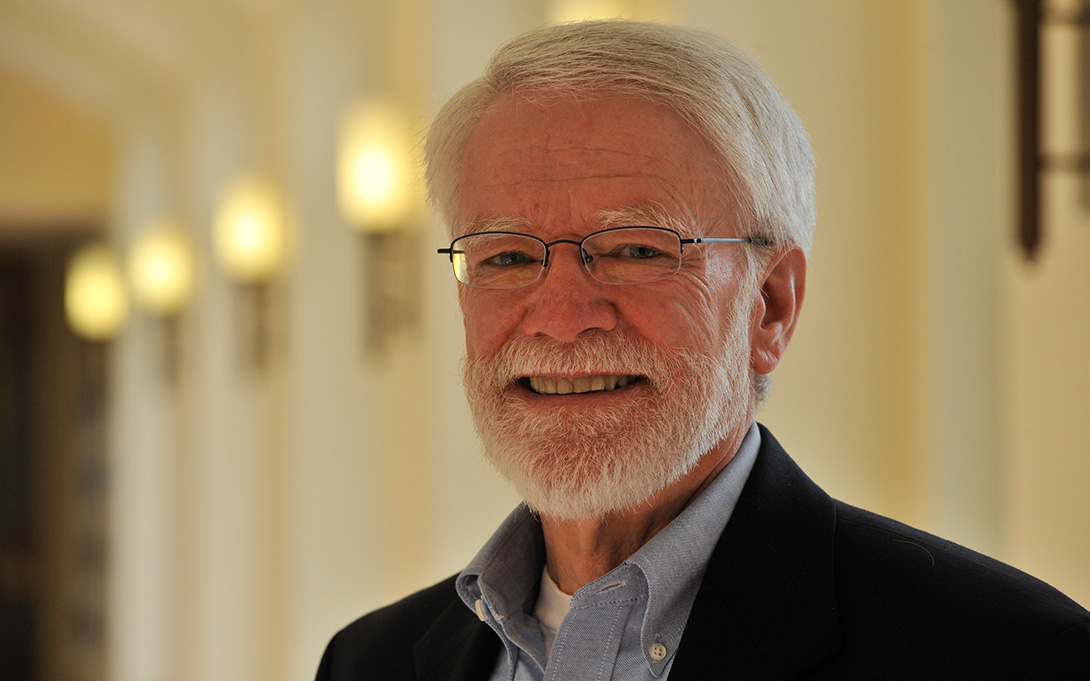
This Saturday, John Chamberlin will board a plane for Paris. He's gearing up for new adventures in retirement. Over the past four decades, he's taught more core courses than any other faculty member at the school, served as interim and associate dean, and helped launch the Ford School's immensely successful undergraduate degree program. He's also been an indispensable sounding board for faculty, staff, and students--a great listener, with irreplaceable institutional knowledge, wise advice, and the kind of long-view that has helped our school grow and mature in so many ways.
John R. Chamberlin is our institutional memory. He was here during the Watergate scandal, and he was here when Gerald Ford assumed the presidency. He was here when the institute became a school, and he was here when the school was renamed in Ford's honor. He's the one who introduced countless numbers of policy students to statistics and ethics, reminding them to weigh society's never-ending quest for efficiency against humanity's deepest-held values. And for 43 years, he's kept us asking the tough questions, like "What Makes Life Worth Living?
If you're looking for a history of the Ford School, or a history of the field of public policy in general, John Chamberlin is the man to see. "I got here in 1970, just a year after the Institute of Public Policy Studies (IPPS) opened its doors," says Chamberlin. While the University had been offering a graduate degree in public administration since 1914, it overhauled the curriculum in 1969 to offer the first Master of Public Policy degree. And this wasn't just the first public policy degree at the University of Michigan--it was the first public policy degree anywhere.
"Today, more than 150 schools in America, and many others across the world, offer degrees in public policy, but it wasn't obvious back then that public policy would succeed as a field," says Chamberlin of the early years. "What was obvious was that problems like poverty, environmental degradation, discrimination, and international conflict weren't going away, and that government badly needed to develop its capacity for better analysis if we were going to craft better public policies."
"The problems facing local, state, and federal government agencies have become more and more complex and typically contain a variety of social, political, scientific, and economic dimensions," wrote Pat Crecine and the interdisciplinary group tasked with establishing a new blueprint for the Institute of Public Administration (IPA). To contend with these thorny problems, Crecine, an associate professor of sociology and political science who would be hired to direct the newly established Institute of Public Policy Studies, advised incorporating "the most recent advances in the social and management sciences" into the public administration curriculum.
Crecine hired Chamberlin the following year to teach one of the new core courses: statistics, which Chamberlin taught in one form or another for the next 30 years. "The new curriculum was preparing students to use data and evidence, and the power of quantitative analysis, to make better public policy," says Chamberlin. "The Pentagon and the Office of Economic Opportunity were leading the way in quantitative policy analysis in the '60s, and demand was growing for people with these skills."
In the late 1970s, Chamberlin added a course of his own to the public policy curriculum: values and ethics in public policy. In 1971, Chamberlin recalls coming across a copy of John Rawls' A Theory of Justice in a Cambridge, MA, bookstore. "I was doing mathematical models of rational choice, and Rawls' underlying argument involved rational choice, so I developed an interest that pointed my teaching and research in a new direction," says Chamberlin. Fortunately for us, it was an interest he couldn't shake.
To Chamberlin, who developed political and policy commitments to justice in an era plagued by injustices (the Vietnam War, poverty, discrimination, and pollution), a course in ethics would add important balance to a policy curriculum then steeped in "quantoid stuff." "Rawls' book was a monumental work," Chamberlin says. "He got justice back into a conversation that had largely been taken over by economics and the norm of efficiency." What began as an elective in the late '70s became a core course in the late '90s, and Chamberlin's prolonged interest in ethics led him to serve as founding director of the University's Center for Ethics in Public Life in 2008.
On the wall of John Chamberlin's office today hangs a T-shirt that reads, "_________ Makes Life Worth Living." Above the line, Chamberlin has inked a single word: "JUSTICE."
"What Makes Life Worth Living?" is a question the Ethics Center posed to the entire University community during an LS&A theme semester in the fall of 2010. "The commitments and dispositions that students develop as undergraduates shape the trajectories of their adult lives," wrote Chamberlin in the project description. "What Makes Life Worth Living?" seeks to call attention to the importance of not letting concern for making a living dominate concern for making a life."
In the long list of responses, one seems particularly apropos as we look back over Chamberlin's contributions to the Ford School: "working to make the world a better place for all to live." That's just the kind of commitment that John Chamberlin brought to public policy, and the kind he inspired in so many of his students over the years.
Below is a formatted version of this article from State & Hill, the magazine of the Ford School. View the entire Spring 2013 State & Hill here.